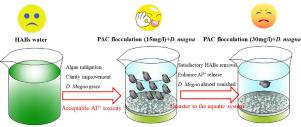Harmful Algae ( IF 5.5 ) Pub Date : 2020-11-03 , DOI: 10.1016/j.hal.2020.101917 Xin Zhou , Yixin He , Hong Li , Yanyan Wei , Lei Zhao , Guofeng Yang , Xudong Chen

|
The frequent occurrence and long-term duration of Microcystis harmful algal blooms (HABs) are of great concern. Chemical flocculation is thought to be an effective way to deal with the HABs, while the application of the flocculants at a high dosage pose potential adverse impacts to the aquatic ecosystems. In this study, an alternative approach is proposed that involves the employment of polyaluminum chloride (PAC) combined with the Daphnia magna (D. magna) to achieve sustainable HABs removal efficiency with an acceptable ecological risk. It was found that under a dense Microcystis HABs (algal density of 1.5 × 107 cells/ml), a PAC dosage of 30 mg/l triggered >95% algae removal, but the released Al3+ caused 90% mortality of planktonic D. magna. Reducing the PAC dosage to 15 mg/l resulted in a slightly lower algal removal efficiency (>90%). In addition the reduced PAC dosage benefited the proliferation of the remaining unicellular algal cells, which tended to form a large colony during the 25-day experiment. Incubation of D. magna following flocculation with 15 mg/l PAC effectively grazed the remaining algal cells, meanwhile increasing the D. magna density by approximately 40-folds, and enlarging the body size by 1.37–1.50 times. This result implied that the released Al3+ was not detrimental to the D. magna. Flocculation with a reduced dosage is sufficient for colonial and large algal cells mitigation, which creates a window time for the biomanipulation of the residual tiny algae. Hence, the subsequent addition of D. magna triggered the sustainable removal of the HABs cells. The present study provides an environmentally friendly strategy for cleaning up the green tides without obvious detrimental effects on the aquatic ecosystem.
中文翻译:

使用絮凝和随后的生物操作来控制微囊藻开花:一项实验室研究
微囊藻有害藻华(HABs)的频繁发生和长期持续时间引起人们的极大关注。化学絮凝被认为是处理HAB的有效方法,而高剂量絮凝剂的使用会对水生生态系统产生潜在的不利影响。在这项研究中,提出了一种替代方法,该方法涉及将聚氯化铝(PAC)与水蚤(Daphnia magna)(D. magna)结合使用,以实现可持续的HAB去除效率并具有可接受的生态风险。发现在致密的微囊藻HAB(藻类密度为1.5×10 7个细胞/ ml)下,PAC剂量为30 mg / l会触发> 95%的藻类去除,但释放的Al3+造成浮游D. magna的90%死亡率。将PAC剂量降低至15 mg / l会导致除藻效率略低(> 90%)。另外,减少的PAC剂量有益于剩余的单细胞藻类细胞的增殖,在25天的实验过程中倾向于形成大菌落。用15 mg / l PAC絮凝后,D。magna的孵化有效地使剩余藻类细胞放牧,同时使D. magna密度增加约40倍,并使体型增加1.37-1.50倍。该结果暗示释放的Al 3+不会对D. magna有害。。减少剂量的絮凝足以缓解结肠和大型藻类细胞,这为残留微小藻类的生物处理创造了窗口时间。因此,随后的D. magna的添加触发了HABs细胞的可持续去除。本研究提供了一种清洁绿色潮汐的环保策略,而对水生生态系统没有明显的有害影响。









































 京公网安备 11010802027423号
京公网安备 11010802027423号